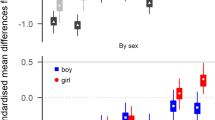Abstract
The independence of hyperactivity, attention deficits, and conduct problems among mentally retarded children was addressed using factors of the Conners' Teacher Rating Scale-39 (CTRS-39) and the more recently developed IOWA Conners' inattention/overactivity (IO) and aggression (A) subscales. CTRS-39 ratings were obtained for children of normal intelligence and for mentally retarded children. Differences between the groups were examined as were intercorrelations of the Conners' factors and IOWA subscales. Conduct problems proved to be less strongly associated with hyperactivity and attention deficits among mentally retarded children compared to children of normal intelligence. However, attention problems and conduct problems may be associated with mental retardation in general. Implications of these data and CTRS scoring system recommendations for mentally retarded children are discussed.
Similar content being viewed by others
References
American Psychiatric Association (1980).Diagnostic and statistical manual of mental disorders (3rd ed.). Washington, DC: Author.
American Psychiatric Association (1987).Diagnostic and statistical manual of mental disorders (3rd ed., rev.). Washington, DC: Author.
Atkins, M. S., Pelham, W. E., & Licht, M. H. (1989). The differential validity of teacher ratings of inattention/overactivity and aggression.Journal of Abnormal Child Psychology, 17, 423–435.
Barkley, R. A. (1989). Attention deficit-hyperactivity disorder. In E. J. Mash & R. A. Barkley,Treatment of childhood disorders (pp. 39–72). New York: Guilford Press.
Conners, C. K. (1980). A teacher rating scale for use in drug studies with children.American Journal of Psychiatry, 126, 884.
Conners, C. K. (1989).Conners' Rating Scales Manual. New York: Multi-Health Systems, Inc.
Cullinan, D., Epstein, M. H., & Dembinski, R. J. (1979). Behavior problems of educationally handicapped and normal pupils.Journal of Abnormal Child Psychology, 7, 495–502.
Fee, V. E., Matson, J. L., & Benavidez, D. A. (1991).Attention deficit hyperactivity disorder among mentally retarded children. Manuscript submitted for publication.
Fisher, W., Burd, L., Kuna, D. P., & Berg, D. J. (1985). Attention deficit disorders and the hyperactivities in multiply disabled children.Rehabilitation Literature, 46, 250–254.
Hinshaw, S. P. (1987). On the distinction between attentional deficits/hyperactivity and conduct problems/aggression in child psychopathology.Psychological Bulletin, 101, 443–463.
Jacobson, J. W. (1982a). Problem behavior and psychiatric impairment within a deveiopmentally disabled population: I. Behavior frequency.Applied Research in Mental Retardation, 3, 121–139.
Jacobson, J. W. (1982b). Problem behavior and psychiatric impairment within a deveiopmentally disabled population: II. Behavior severity.Applied Research in Mental Retardation, 3, 369–381.
Koller, H., Richardson, S. A., Katz, M., & McLaren, J. (1982). Behavior disturbance in childhood and the early adult years in populations who were and were not mentally retarded.Journal of Preventive Psychiatry, 1, 453–468.
Lahey, B. B., Green, K. D., & Forehand, R. (1980). On the independence of ratings of hyperactivity, conduct problems, and attention deficits in children: A multiple regression analysis.Journal of Consulting and Clinical Psychology, 48, 566–574.
Loney, J., & Milich, R. (1982). Hyperactivity, inattention, and aggression in clinical practice. In M. Wolraich & D. Routh (Eds.),Advances in developmental and behavioral pediatrics (Vol. 3, pp. 113–147). Greenwich, CT: JAI Press.
Matson, J. L., Epstein, M. H., & Cullinan, D. (1984). A factor analytic study of the Quay-Peterson scale with mentally retarded adolescents.Education and Training of the Mentally Retarded, 19, 150–154.
Newcorn, J. H., Halperin, J. M., Healey, J. M., O'Brien, J. D., Pascualvaca, D. M., Wolf, L. E., Morganstein, A., Sharma, V., & Young, J. G. (1989). Are ADDH and ADHD the same or different?Journal of the American Academy of Child and Adolescent Psychiatry, 285, 734–738.
Pelham, W. E., Milich, R., Murphy, D. A., & Murphy, H. A. (1989). Normative data on the IOWA Conners Teacher Rating Scale.Journal of Clinical Child Psychology, 18, 259–262.
Rutter, M., Tizard, J., & Whitmore, K. (1970).Education, health, and behavior. New York: Wiley.
Sattler, J. M. (1988).Assessment of children (3rd ed.). San Diego: Jerome M. Sattler.
Wechsler, D. (1974).Manual for the Wechsler Intelligence Scale for Children-Revised. San Antonio: The Psychological Corporation.
Author information
Authors and Affiliations
Rights and permissions
About this article
Cite this article
Fee, V.E., Matson, J.L., Moore, L.A. et al. The differential validity of hyperactivity/attention deficits and conduct problems among mentally retarded children. J Abnorm Child Psychol 21, 1–11 (1993). https://doi.org/10.1007/BF00910485
Revised:
Issue Date:
DOI: https://doi.org/10.1007/BF00910485




